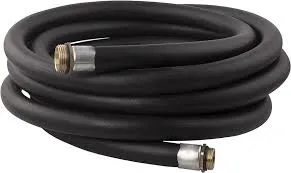335345435
Oct . 17, 2024 07:09 Back to list
Manufacturing Plant for Petroleum Gasoline Oil and Rubber Delivery Hoses
The Evolution and Importance of Petroleum, Gasoline, Oil, and Rubber Delivery Hoses
In the world of industrial applications, the safe and efficient transport of fluids is critical. Among the key components involved in this process are delivery hoses designed for petroleum, gasoline, oil, and rubber. These hoses are indispensable for various sectors, including automotive, petrochemical, and manufacturing. The evolution, manufacturing processes, materials used, and safety standards associated with these hoses highlight their importance in modern industry.
The Evolution of Delivery Hoses
The history of delivery hoses can be traced back to the early 20th century when the demand for petroleum and gasoline rose dramatically with the advent of the automobile. Initially, hoses were made from leather or cloth, which proved inadequate for handling the high pressures and corrosive nature of petroleum products. As industries advanced, so did the materials used for these hoses. The introduction of synthetic rubber in the mid-20th century transformed hose manufacturing. This innovative material provided better durability and resistance to wear and tear, significantly enhancing the performance and longevity of delivery hoses.
Manufacturing Processes
The manufacturing of petroleum, gasoline, oil, and rubber delivery hoses involves several intricate processes. Typically, manufacturers begin with the selection of high-quality raw materials. Synthetic rubbers, such as nitrile or neoprene, are commonly used due to their excellent resistance to oil and gasoline. These materials are then blended with other compounds to enhance specific properties such as flexibility, strength, and temperature resistance.
The hoses are usually constructed in layers for added durability. The innermost layer is designed to handle the fluid, while the outer layers comprise reinforcement materials such as textile or steel wire, providing structural integrity and protection against abrasion. After forming the hose, manufacturers subject it to rigorous testing to ensure compliance with industry standards. Tests may include pressure testing, bend testing, and exposure to various chemicals to ensure that the hose can withstand the operational conditions it will face in the field.
Importance of Safety Standards
petroleum gasoline oil rubber delivery hose factory

Given the volatile nature of the fluids these hoses transport, adherence to safety standards is paramount. Regulatory bodies, including the American Petroleum Institute (API) and the Underwriters Laboratories (UL), set rigorous guidelines that manufacturers must follow. These standards ensure that hoses can handle the pressures and temperatures typical of petroleum and gasoline applications without failing.
Moreover, safety also extends to the user. The design of delivery hoses incorporates features to prevent leaks or spills during transport, which can lead to environmental hazards. Additionally, proper maintenance practices, such as regular inspections for wear and tear and replacing hoses as needed, are vital in prolonging the life of the hoses and ensuring safe operations.
Applications Across Various Industries
Delivery hoses crafted for petroleum and gasoline are used in a myriad of applications. In the automotive industry, they are essential for fueling systems and engine applications. In the petrochemical industry, these hoses transport crude oil and refined products from refineries to distribution centers. Furthermore, construction and manufacturing industries rely on these hoses for transferring materials like lubricants and hydraulic oils for machinery.
The versatility of rubber delivery hoses also extends to non-petroleum products, proving valuable in the transport of solvents, chemicals, and even food-grade products in specialized applications.
Conclusion
The petroleum, gasoline, oil, and rubber delivery hose industry continues to evolve, blending technological advancements with robust safety measures. As industries grow more complex and the demand for effective fluid transport increases, the importance of high-quality delivery hoses cannot be overstated. These components are not merely functional; they represent a vital link in the supply chain that underpins numerous sectors of the global economy. Investing in high-quality hoses and adhering to safety standards will ensure a reliable and sustainable future for fluid transport in various industries.
-
SAE 100 R17 Black Smooth Cover Hydraulic Hose
NewsMar.07,2025
-
SAE 100 R17 Black Smooth Cover Hydraulic Hose
NewsMar.07,2025
-
SAE 100 R17 Black Smooth Cover Hydraulic Hose
NewsMar.07,2025
-
SAE 100 R17 Black Smooth Cover Hydraulic Hose
NewsMar.07,2025
-
SAE 100 R17 Black Smooth Cover Hydraulic Hose
NewsMar.07,2025
-
steel wire braided hydraulic hose
NewsMar.07,2025



